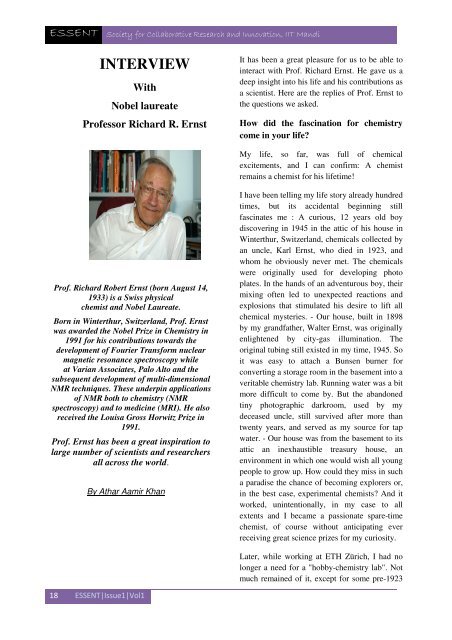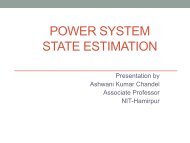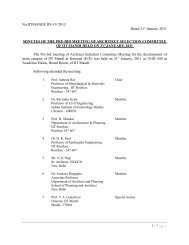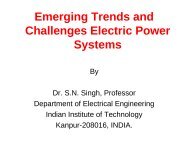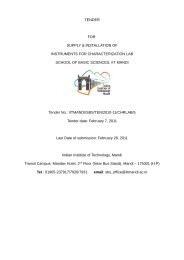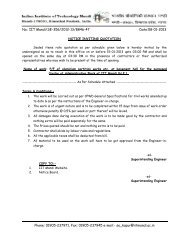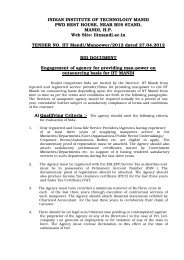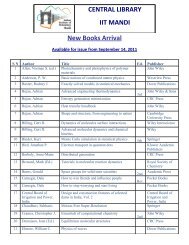ESSENT Society for Collaborative Research and Innovation, <strong>IIT</strong> <strong>Mandi</strong>INTERVIEWWithNobel laureateProfessor Richard R. ErnstIt has been a great pleasure for us to be able tointeract with Prof. Richard Ernst. He gave us adeep insight into his life and his contributions asa scientist. Here are the replies of Prof. Ernst tothe questions we asked.How did the fascination for chemistrycome in your life?My life, so far, was full of chemicalexcitements, and I can confirm: A chemistremains a chemist for his lifetime!Prof. Richard Robert Ernst (born August 14,1933) is a Swiss physicalchemist and Nobel Laureate.Born in Winterthur, Switzerland, Prof. Ernstwas awarded the Nobel Prize in Chemistry in1991 for his contributions towards thedevelopment of Fourier Transform nuclearmagnetic resonance spectroscopy whileat Varian Associates, Palo Alto and thesubsequent development of multi-dimensionalNMR techniques. These underpin applicationsof NMR both to chemistry (NMRspectroscopy) and to medicine (MRI). He alsoreceived the Louisa Gross Horwitz Prize in1991.Prof. Ernst has been a great inspiration tolarge number of scientists and researchersall across the world.By Athar Aamir KhanI have been telling my life story already hundredtimes, but its accidental beginning stillfascinates me : A curious, 12 years old boydiscovering in 1945 in the attic of his house inWinterthur, Switzerland, chemicals collected byan uncle, Karl Ernst, who died in 1923, andwhom he obviously never met. The chemicalswere originally used for developing photoplates. In the hands of an adventurous boy, theirmixing often led to unexpected reactions andexplosions that stimulated his desire to lift allchemical mysteries. - Our house, built in 1898by my grandfather, Walter Ernst, was originallyenlightened by city-gas illumination. Theoriginal tubing still existed in my time, 1945. Soit was easy to attach a Bunsen burner forconverting a storage room in the basement into averitable chemistry lab. Running water was a bitmore difficult to come by. But the abandonedtiny photographic darkroom, used by mydeceased uncle, still survived after more thantwenty years, and served as my source for tapwater. - Our house was from the basement to itsattic an inexhaustible treasury house, anenvironment in which one would wish all youngpeople to grow up. How could they miss in sucha paradise the chance of becoming explorers or,in the best case, experimental chemists? And itworked, unintentionally, in my case to allextents and I became a passionate spare-timechemist, of course without anticipating everreceiving great science prizes for my curiosity.Later, while working at ETH Zürich, I had nolonger a need for a "hobby-chemistry lab". Notmuch remained of it, except for some pre-192318 ESSENT|Issue1|Vol1
ESSENT Society for Collaborative Research and Innovation, <strong>IIT</strong> <strong>Mandi</strong>bottles that moved 1977 with us to our newlybuilt home again in Winterthur. At that time, Idid not plan for another hobby chemistry lab.Chemistry had long before turned into my“earnest” profession. My other passions,emerging besides chemistry, playing the cello,and much later collecting Tibetan painting artdid not require chemical facilities. The passionswere rather complementary to my“professional” activities, each with its ownpersonal relevance and fascination, as I willexplain briefly in the following.Playing music fascinated me already very earlyin my youth, much before my interest forchemistry emerged from the mentioneddiscovery in the attic. I was born as anintroverted person with difficulties to establishverbal human contacts. Music became a way tolive out my inhibited emotions. Fortunately, Igrew up in the midst of a spectacular musicalatmosphere; our old house stood just 100 metersfrom the home of the legendary music patron ofWinterthur, Werner Reinhart. Many worldfamousmusicians were guests in his hospitablehouse just across the street from ours, and someof them were composing immortal music forhim and for the Winterthur symphony orchestrain which he occasionally played the basset hornand the bass clarinet. Among them were IgorStravinsky, Anton Webern, Paul Hindemith,Arthur Honegger, Frank Martin, Adolf Busch,and Othmar Schoeck . Inspired by these musicalheroes, whom I often met at the frequentlyclosed railroad gate when going to school, Istarted to play the cello and to compose musicmyself. Most of it has never been performed nordeserves a performance. But looking back, thecreativity of composing music was for mesimilarly satisfactory as writing a scientificmanuscript in my later years.Music developed for me into a most relevantsocietal link, also towards my wife Magdalenaas her love for music exceeds the one forchemistry. Actually, we met for the very firsttime at a private musical party; she played theviolin and I the cello, and it seemed toharmonize. - My attraction to music possessesalso historical aspects. The MusikkollegiumWinterthur is an ancient institution, dating backto 1629. From its beginning, gifted members ofthe family Ernst were actively taking part inmusical performances. My musical interestsdeveloped, so to say, by default and wererelevant for my participation in local socialactivities. They allowed me to interact also withmy "non-chemical" fellow-citizens. I stillremember how some passengers in thecommuter train wrinkled their noses and evenopened the windows near to me, during myreturning in the evening to Winterthur afterhaving spent 8-10 hours in a smelly chemistrylab at ETH Zürich! This revealed to me howmuch chemistry was disliked by my philistinecompatriots!My relation to Tibetan and Central Asianpainting art has a more direct chemicalrelevance. The fascination for Asian artdeveloped accidentally during a touristicjourney through Asia, and particularly Nepal, in1968, while returning to Switzerland afterhaving spent four and a half professional yearsat Varian Associates in Palo Alto, California. AtVarian, I was successful by introducing theFourier transform concept that increased thesensitivity by several orders of magnitude [4]. Itgave NMR a major push and finally led to my“little Prize” received in Stockholm inDecember 1991. In order to keep this shortessay in bounds, I refrain from a discussion ofmy research work in NMR spectroscopy.My unexpected encounter with TibetanBuddhist art in Nepal was indeed “love on thefirst sight”. I was immediately fascinated by thebold colorfulness of the paintings and theskillful drawing of great details. This art has, atthe same time, the qualities of naive children’sart and of most sophisticated and expressivemediaeval European art. It is art conceived andexecuted by “unspoiled” pure minds that havenot yet learned to depicture pseudo-feelings of adecadent and money-minded Western "high"society. Although Tibetan art from beyond the19 ESSENT|Issue1|Vol1


